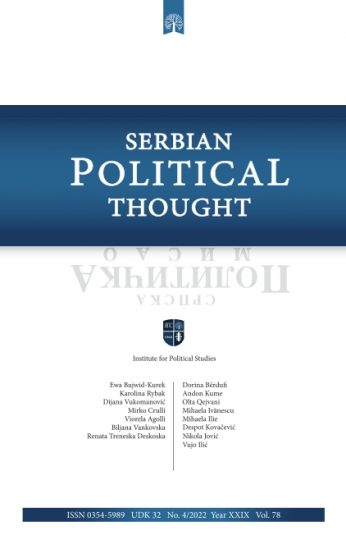Main topic
Contents
Types of Autonomy, Representation, and Participation of the Subnational Political Communities in the Western Balkans: The Case Study of Serbia, the Former Yugoslav Republic Macedonia and Kosovo (under UNSCR 1244/1999)
Abstract
Borders are changing constantly in the turbulent Balkan region. In the same vein the status of one community from majority to minority changes overnight. This work aims to, through comparative analysis, examine how the subnational political communities are integrated in Serbia, FYR Macedonia, and Kosovo by discussing three elements: autonomy, representation, and participation. The work is going to illustrate the applicability of Arend Lijphart’s consociational democracy elements in FYR Macedonia, limited applicability in Kosovo, and despite the existence of some elements the non-existence of consociational- ism in Serbia. The work underlines the role of international community, and the armed conflicts in establishing certain provisions that are tangible to the subnational political communities. Finally, the work seeks to demonstrate the importance of the communicating vessels principle in the counties and entities in question.
References
- Ahtisaari, M. (2007) Comprehensive Proposal for the Kosovo Status Settlement.
- Benedikter, T. (2006) The working autonomies in Europe: An overview and schematic comparison, Hunsor Humans Rights Watch [online]. Available at: http://www.hunsor.se/dosszie/working_autonomies.pdf [Accessed 18 July 2016].
- Bieber, F. (2002/03) Balancing Political Participation and Minority Rights: The Experience of the former Yugoslavia, European Centre for Minority Issues, [online]. Available at: http://pdc.ceu.hu/archive/00001819/01/Bieber.pdf [Accessed 18 July 2016] .
- Bieber, F. (2004) “Power Sharing as Ethnic Representation in Post-conflict Societies: The Cases of Bosnia, Macedonia and Kosovo”. In: Mungiu-Pippidi, A. and Krastev, I. (eds.) “Nationalism after Communism. Lessons Learned“, Budapest: CEU Press. pp. 229-246.
- Bochsler, D. (2010) “Electoral Rules and the Representation of Ethnic Minorities in PostCommunist Democracies”, in: European Yearbook of Minority Issues Online, Volume 7 (Issue 1): pp. 153-180.
- Council of Europe (1995) “Framework Convention for the Protection of National Minorities”. Strasbourg: European Treaty SeriesNo. 157.
- Cohen, L. & Lampe, R. J. (2011) “Embracing Democracy in the Western Balkans: From Post-conflict struggles toward European Integrations”. Washington D.C. and Baltimore: Woodrow Wilson Center Press, The John Hopkins University Press.
- Constitution (2008) of the Republic of Kosovo.
- Constitution (1991) of the Republic of Macedonia.
- Law (2011) on Election of Deputies, Official Gazette, Serbia.
- Law (2009) on National Councils of National Minorities, Official Gazette, Serbia.
- Law (2009) on Political Parties, Official Gazette, Serbia.
- Law (2002) on Protection of Rights and Freedoms of National Minorities, Official Gazette, Serbia.
- Law (2006) on the Use Languages, Assembly of Kosovo.
- Law (2008) on Self-governance, Assembly of Kosovo.
- Lijphart, A. (1977) “Democracy in Plural Society: A Comparative Exploration”. New Haven and London: Yale University Press.
- Lončar, J. (2011) Izborna formula i reprezentacija manjina, Projekat 179076 “Politički identitet Srbije u regionalnom i globalnom kontekstu“, Ministarstvo za nauku i tehnološki razvoj Republike Srbije.
- Lyon, A. (2001) “Municipal Decentralisation: Between the Integration and Accommodation of Ethnic Difference in the Republic of Macedonia” In Risteska, M., Daskalovski Z. (eds.) “One Decade after the Ohrid Framework Agreement: Lessons (to be) Learned from the Macedonian Experience”, Skopje: Friedrich Ebert Stiftung and Center for Research and Policy Making. pp. 86-116.
- Malazogu, L, Ejdus, F, Nič, M, Žornaczuk, T. (2014) Integration or Isolation? Northern Kosovo in 2014 Electoral Limbo, Central European Policy Institute, [online] Available at: https://www.researchgate.net/publication/277544864_ Integration_or_Isolation_Northern_Kosovo_in_2014_Electoral_ Limbo [Accessed 18 July 2016].
- Marko, J. (2008) “The New Kosovo Constitution in a Regional Comparative Perspective”, in: Review of Central and East European Law, 33, pp. 437-450.
- OSCE (1999), “The Lund Recommendations on the Effective Participation of National Minorities in Public Life & Explanatory Note”.
- Provincial Assembly Decision on the Election of Deputies to the Assembly of the Autonomous Province of
List of Interviews
Serbia
- Slaven Bačić, Subotica, August 17th, 2016
- Balint Pasztor, Subotica, August 17th, 2016
- Ksenija Marković, Belgrade, August 18th, 2016
- Nebojša Vladisavljević, Belgrade, August 19th, 2016
- Jelena Marjanović, Belgrade, August 22nd, 2016
Kosovo
- Nexhmedin Spahiu, Mitrovica South, September 04th, 2016
- Jovan Aleksić, Mitrovica North, September 04th, 2016
- Milica Andrić, Mitrovica North, September 05th, 2016
- Dijana Hasani, Mitrovica North, September 05th, 2016
- Ana Marija Ivković, Mitrovica North, September 05th, 2016
FYR Macedonia
- Agon Demjaha, Skopje, September 07th, 2016
- Zhidas Daskalovski, Skopje, September 07th, 2016
- Veton Latifi, Skopje, September 07th, 2016
- Kaltrina Selimi, Skype, September 08th, 2016
- Dane Taleski, Skopje, September 09th, 2016
- Veton Latifi, Skopje, September 07th, 2016
- Kaltrina Selimi, Skype, September 08th, 2016
- Dane Taleski, Skopje, September 09th, 2016

